Diseases, along with pests, are the causes of the most common anthurium plant problems.
As an anthurium enthusiast, I know firsthand the joy these stunning tropical plants can bring into a home. But like all living things, anthuriums can fall victim to various diseases threatening their health.
Whether you’re a seasoned anthurium grower or an occasional enthusiast, understanding the common diseases that can afflict these plants is vital to keep them thriving.
In this guide, I’ll share my personal experiences and research to help you identify, prevent, and treat the most prevalent anthurium diseases. Let’s go!
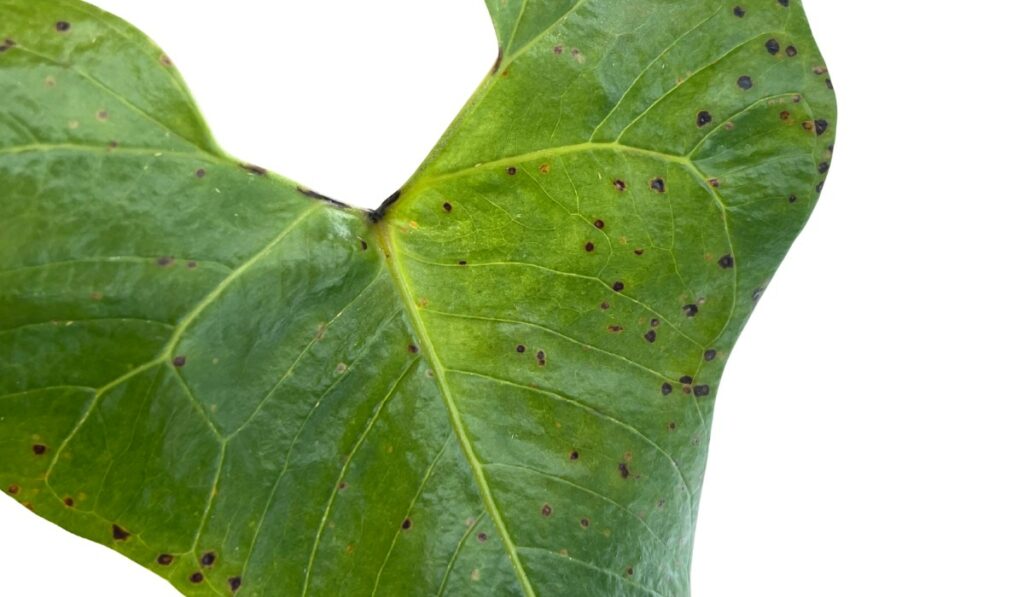
The Most Common Anthurium Diseases
Anthuriums are susceptible to a variety of diseases. Fungal or bacterial infections cause the most common diseases in anthurium plants. Here’s a brief overview of some of the most common ones:
Bacterial Diseases
Bacterial Blight
Bacterial blight is a disease caused by the bacterium Xanthomonas axonopodis.
Symptoms
If you’re growing anthuriums and notice water-soaked spots near the leaf edges, yellowing around those spots, or dark brown discoloration on the main stem, you might be dealing with bacterial blight. These spots can eventually merge, causing larger dead areas on the leaves.
Usually, a bright yellow band separates the dead from the live tissue. Watch for these signs, as they could indicate a problem that needs your attention.
Treatment
If you encounter anthurium blight, don’t worry; there are steps you can take. This disease can be tricky to deal with, but the focus should be on prevention and containment.
If you’re lucky enough not to have it, keep it at bay by being mindful of the tools and materials you use – aka make sure they are sterile.
If it does appear, the best approach is to remove and destroy all infected plants, whether or not the infection seems widespread. It’s a tough measure, but it helps prevent the disease from spreading further and infecting your other anthuriums.
Liquid copper spray can be used as a preventative treatment against bacterial blight in anthuriums, especially when applied early. However, relying solely on this method might not be enough to eradicate the problem entirely.
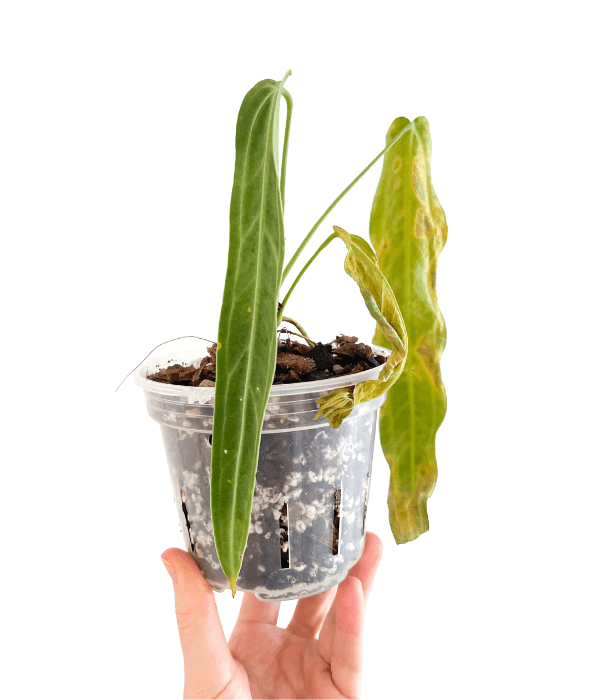
Bacterial wilt
Bacterial wilt in anthuriums is a serious disease often caused by bacteria such as Ralstonia solanacearum. It affects the vascular system of the plant, leading to wilting and potentially death.
Symptoms
Early signs include wilting of leaves, especially during the day’s heat. As the disease progresses, wilting becomes permanent, and the stems may become discolored or exhibit a slimy ooze.
Cutting into the stem may reveal a brown discoloration of the vascular tissue.
Treatment
Fungicides containing phosphorous acid can be used for prevention, although they don’t cure already infected plants. Your best course of action is to get rid of the plant before it infects other plants in your collection.
Bacterial Leaf Spot
Bacterial leaf spot is usually characterized by small, water-soaked spots on leaves that may have a sticky exudate.
The spots might enlarge and coalesce, leading to more extensive damage, but they typically don’t develop the same distinct yellow halo associated with bacterial blight disease.
These patches can become mushy. The lack of proper airflow usually causes the disease’s rapid spread.
Treatment
Try using copper-based sprays to treat the affected plant but cutting the infected leaves is the best way to tame the disease from spreading.
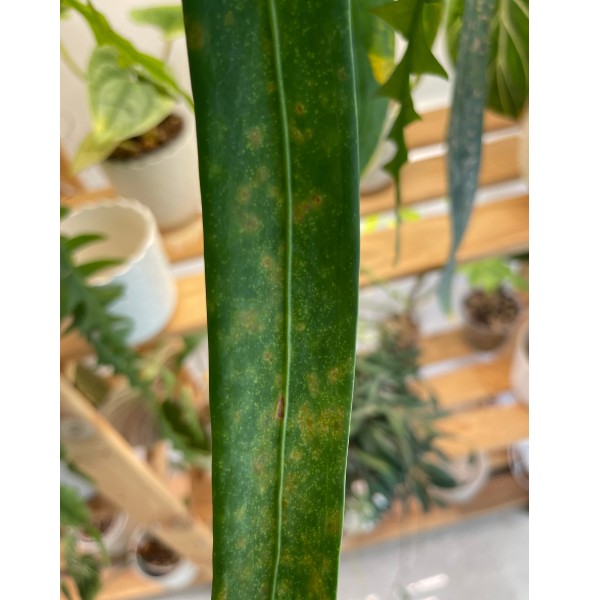
Fungal diseases
Root Rot
Root rot in anthuriums is typically caused by soilborne fungi such as Pythium, Phytophthora, and Rhizoctonia. Root rot will destroy your plant if you don’t catch it in time.
Overwatering is the main culprit in the development of root rot. Proper potting mix and adequate watering schedule are the best prevention. I have dedicated guides to ideal potting soil mix for anthuriums, how & when to water anthuriums, and when to repot them. Check them out!
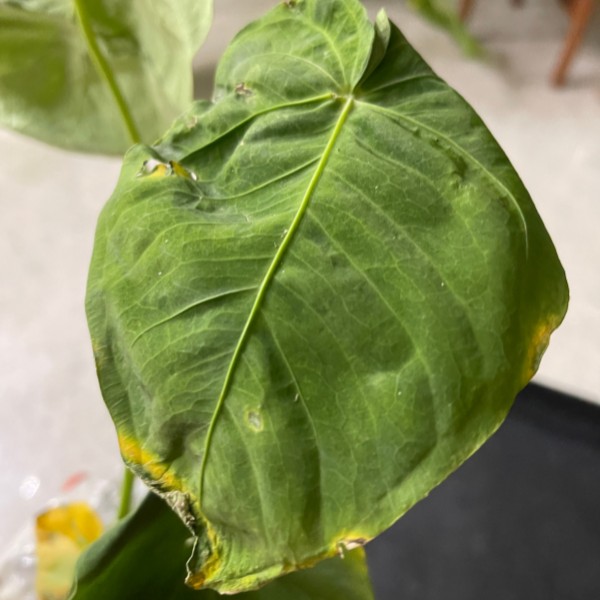
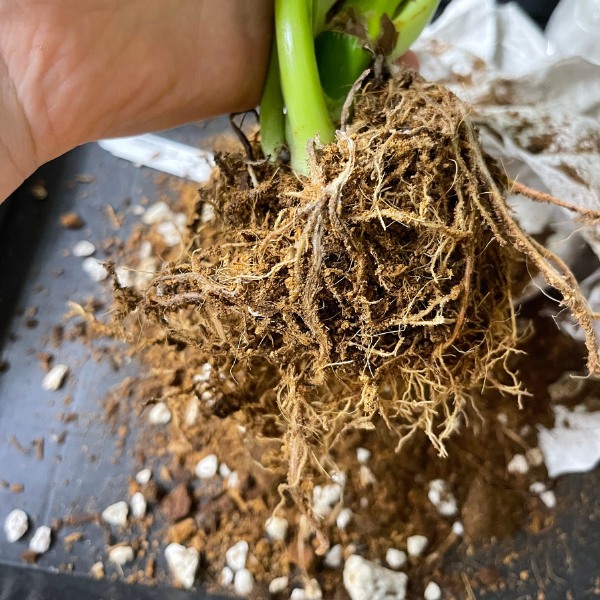
Irregular watering can induce root rot disease.
For example, during transport, the medium in which the anthuriums are placed often dries out excessively. Trying to rehydrate the plants by soaking them in water can inadvertently cause the roots to rot.
The balance between too much and too little water is delicate, and improper handling during transportation and rehydration can easily tip the scales, inducing root rot among other acclimatization issues.
Symptoms
- Root Discoloration: The roots become brown or black, soft, and mushy, losing their healthy white or light tan appearance. When you pull on them, they easily break.
- Stunted Growth: Affected plants may exhibit slow or stunted growth. Usually, your anthurium will stop growing altogether.
- Yellowing or Wilting of Leaves: The leaves might turn yellow, wilt, or droop due to the reduced ability of the roots to absorb water and nutrients. Yellowing leaves can be a symptom of many problems, but I always check the roots first. Having clear plastic pots where you can see the roots greatly helps.
Treatment
If the disease is detected early, fungicide treatments might be used to control the spread of the fungi. Replace the soil with a new one and use fungicides to help the anthurium recover.
You might still save your anthurium if you catch root rot early enough. I suggest removing the dead roots and soaking the plant in hydrogen peroxide for 15 minutes to kill all the pathogens. Then, repot the plant in fresh aroid potting mix.
Alternatively, if your anthurium has any roots above the ground, you could try topping it by chopping off the top with some roots and rerooting the plant in sphagnum moss.
Black nose disease
Black nose disease manifests as black, necrotic spots at the tips or margins of the spathe, the colorful, modified leaf that surrounds the spadix in anthurium flowers.
Symptoms
The main symptom is the appearance of dark black spots or areas at the tips or edges of the spathe. These can spread, leading to a distorted and unattractive flower. The condition is typically caused by exposure to cold temperatures or cold drafts.
Treatment
The best approach is prevention, which includes maintaining steady temperatures and avoiding cold drafts. Remove the damaged flower if the plant is healthy and only the spathe is affected. This will allow the plant to produce healthy new flowers in the future.
You may spot it if you’re growing Flamingo plant, aka Anthurium andraeanum.
Powdery mildew
Powdery mildew in anthurium is caused by various species of fungi.
Symptoms
Powdery mildew appears as white to gray powdery spots or patches on the leaves and sometimes the stems. It may cause the leaves to become distorted or discolored.
Treatment
Ensure proper air circulation and treat with fungicide.
Fungal Leaf Spot
There are several fungi that can cause leaf spot diseases in anthuriums, including Cercospora and Colletotrichum. Infected leaves develop dark, water-soaked spots.
Symptoms
Fungal leaf spots show up as small brown spots that can appear with a yellow center. Usually, improper air flow is to blame for the development of this disease.
Treatment
Cut off the infected leaves before the disease takes over the whole plant. Treat the plant with a fungicide and increase airflow. Try to create an environment that is not overly cool or damp, as these are the ideal conditions for developing the disease.
Correctly identifying what disease your infected plant has is not easy, and I can’t say I’m a pro at it. That’s why I almost always prefer pests attacking my anthuriums to diseases. They are much easier to deal with than bacterial or fungal diseases.
It is not always easy to distinguish between the two. Sometimes old spider mites damage can look like a bacterial disease.
That said, here are some examples of either bacterial or fungal diseases that got to my anthuriums:
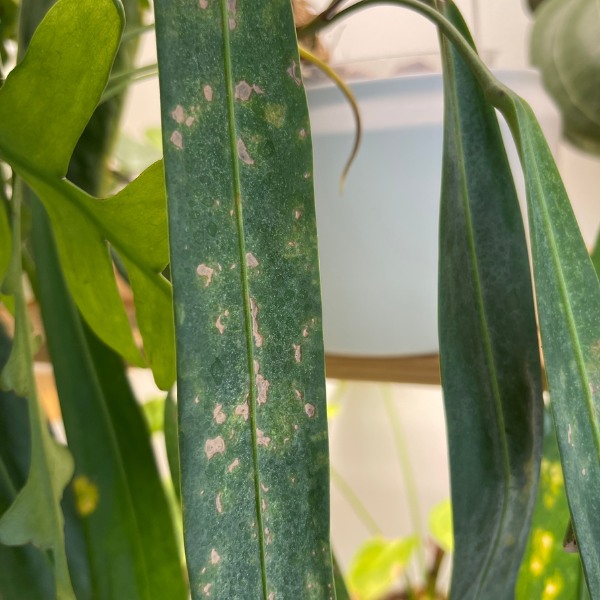
You can see here damage done by either bacteria or fungi on my Anthurium friedrichsthalli. The wounds are deep into the lead tissue.
Common advice is to cut off the infected leaves as the disease might spread to other leaves or nearby plants. But I’m such a sucker when it comes to drastic measures. I would have tried all sorts of treatments before I managed to chop off the leaf.
Mosaic Virus – What is it and how to spot it
Viruses, along with bacteria and fungi, can pose threats to your anthurium plants. Among them, one particular virus has been drawing attention among plant enthusiasts – the mosaic virus.
Dasheen Mosaic Virus (DsMV) is a virus occurring in plants in the Araceae family, including anthurium. This virus is transmitted by aphids or through infected plant material, causing mottled or mosaic-like patterns on the leaves. Various strains of viruses cause the infection.
Symptoms include irregular, streaked, or mottled patterns on the leaves with varying shades of green. These lead to deformities and stunted growth. There’s no cure for the mosaic virus, so prevention is crucial for commercial growers.
For houseplant enthusiasts, it means being more vigilant when acquiring plants to add to your collection.
Sometimes it is difficult to tell whether you’re dealing with a mosaic virus or variegation! Some unscrupulous sellers will try to sell you an infected plant and pass it as a variegated one at a steep price! Be wary.
If you doubt, you can send the suspected virus-infected plant tissue to the lab. Or, you can opt for a home testing kit if available in your country.
Fun fact: Interestingly, in anthurium plants, even if they do produce inflorescence and seed, the virus would not transfer to the seed or seedlings.
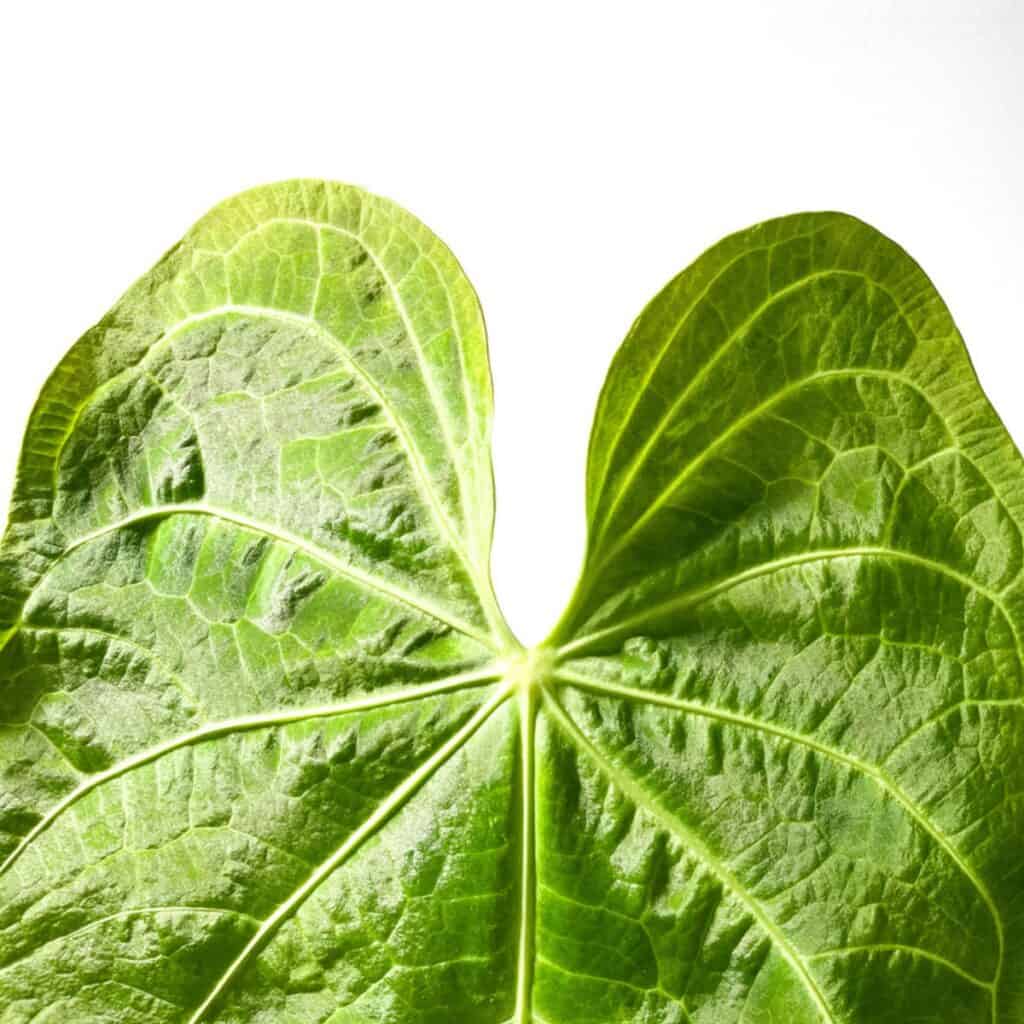
How to Prevent Diseases from Attacking Your Anthurium
Diseases are inevitable in the plant-growing experience, whether you’re a novice or a pro, and you’ll encounter them sooner or later. The key to preventing diseases is focusing on prevention and creating the right conditions for your anthuriums to thrive indoors.
Good airflow is essential; cutting back on misting is vital when proper airflow is lacking. Cool and damp conditions and a lack of airflow are environments where bacteria and fungus flourish, so maintaining the right balance is paramount in keeping your anthuriums healthy.
With that said, here are some tips on preventing diseases from attacking your anthuriums:
- Regular Inspection & Cleaning: Keep a close eye on your anthuriums for early signs of disease. Early detection can lead to quicker and more effective treatment. Remove dead or diseased leaves to prevent them from becoming a breeding ground for diseases. This is painful as often your anthurium is a two-leafer, but quite necessary.
- Proper Watering: Overwatering can lead to root rot and other fungal diseases. Avoid wetting leaves if they won’t dry off quickly. Cool, damp, and wet conditions can be a breeding ground for pathogens. That’s why I always recommend watering or spraying your anthuriums during the day when there’s enough light for proper photosynthesis and water absorption. Watering appropriately and ensuring good drainage can prevent conditions that favor root rot. Check out my guide on how to water anthurium.
- Good Air Circulation: Anthuriums love humidity. But a buildup of humidity without proper air movement can foster disease. This is one of the reasons you need to have a fan if you’re growing your anthuriums in an Ikea cabinet-like setup.
- Adequate light: Too little light will weaken your Anthuriums and, therefore, make you more susceptible to diseases. I wrote an entire guide on light requirements for anthuriums; take a look.
- Sanitize Tools: Always clean and sterilize pruning tools between uses to prevent the spread of diseases.
- Use the Right Soil Mix: A well-draining soil mix can prevent waterlogging and the onset of diseases like root rot. Waterlogged soils with poor drainage create an environment that encourages the growth of fungi responsible for root rot.
Choosing the right soil mix can mitigate these issues and keep your plants healthy. My Anthurium gladiifolium got yellow spots when I repotted it to a bit more dense potting mix. It was drying out too quickly, so I repot it in a more water-retentive substrate. Mistake! The plant didn’t like it. Recognizing my error, I reverted to a less dense medium and adjusted my watering routine. Now, we’re friends again, and the plant seems much happier.
- Avoid Overcrowding: Give your plants enough space to ensure proper air circulation, minimizing the risk of fungal and bacterial diseases.
- Quarantine New Plants: Isolate newly acquired anthuriums from your existing collection until you’re sure they’re disease-free.
- Avoid Over-Fertilization: Using the right amount of fertilizer prevents excessive growth that might be susceptible to diseases. Follow recommendations specific to anthuriums.
I hope this guide will help you better identify the most common anthurium diseases. Happy planting to all my fellow anthurium enthusiasts! May your indoor jungles grow disease-free.

